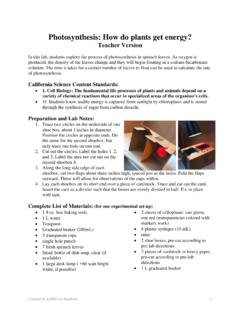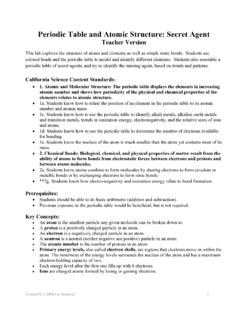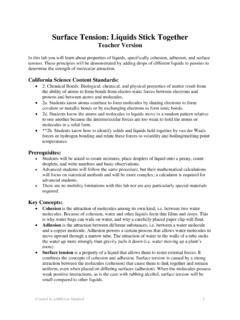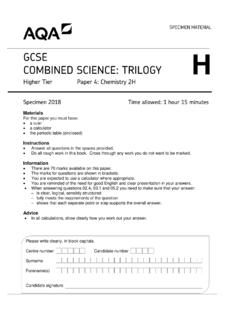Transcription of Stoichiometry: Baking Soda and Vinegar Reactions
1 Created by LABScI at Stanford 1 stoichiometry : Baking soda and Vinegar Reactions Teacher Version In this lab, students will examine the chemical reaction between Baking soda and Vinegar , and mix different amounts of these household chemicals to learn about the concept of stoichiometry . California Science Content Standards: 3. Conservation of Matter and stoichiometry : The conservation of atoms in chemical Reactions leads to the principles of conservation of matter and the ability to calculate the mass of products and reactants. 3a. Students know how to describe chemical Reactions by writing balanced equations.
2 4. Gases and Their Properties: The kinetic molecular theory describes the motion of atoms and molecules and explains the properties of gases. 4c. Students know how to apply the gas laws to relations between the pressure, temperature, and volume of any amount of an ideal gas or any mixture of ideal gases. **4h. (advanced only) Students know how to solve problems by using the ideal gas law in the form of PV=nRT. Prerequisites: Students should be able to do division and multiplication, or have access to a calculator. Previous exposure to chemical Reactions would be beneficial, but is not required.
3 Key Concepts: stoichiometry is the quantitative balancing of elements in chemical Reactions . Conservation of mass requires that all atoms that enter a reaction as reactants must exit the reaction in the products. The Ideal Gas Law is used to model equilibrium conditions of most gases, relating the pressure, volume, temperature, and moles of gas. Introductory Lecture: stoichiometry describes the quantitative relationship between reactants and/or products in a chemical reaction. In chemistry, Reactions are frequently written as an equation, using chemical symbols. The reactants are on the left side of the equation, and the products are on the right.
4 The law of Conservation of Mass tells us that matter is neither created nor destroyed in a chemical reaction. Because of this, a proper chemical equation must be balanced; the number of atoms of an element on one side of the equation has to match the number of atoms of that element on the other side. A mole is a unit of measurement just like a dozen eggs is 12 eggs. A mole, which was chosen because it is the number of atoms in 12 grams of carbon , is known as Avogadro s Created by LABScI at Stanford 2 Number: x 1023. The number of grams in a mole differs from substance to substance just like a dozen eggs has a different weight than a dozen elephants, a mole of oxygen has a different weight than a mole of hydrogen even though in each case, there are x 1023 atoms.
5 Using the concept of stoichiometry , the amount of product that results from a chemical reaction can be predicted. Baking soda is a powdered chemical compound called sodium bicarbonate, and Vinegar includes acetic acid. These 2 components react in solution to form carbon dioxide , water, and sodium acetate as shown in the chemical reaction below: NaHCO3 (aq) + CH3 COOH (aq) ----> CO2 (g) + H2O (l) + CH3 COONa (aq) stoichiometry can be used to predict the amount of carbon dioxide released in this process. Conservation of mass requires that all atoms that enter a reaction as reactants must exit the reaction in the products.
6 Consider the example of decomposing water into Hydrogen and Oxygen gas: 2H2O (l) ----> 2H2 (g) + O2 (g) The coefficients in this equation indicate that exactly 2 water molecules are needed to form 2 hydrogen molecules and one oxygen molecules. One can see the necessity of these coefficients by considering their omission: H2O (l) ----> H2 (g) + O2 (g) In this case, there is only one oxygen atom on the reactant side, with two oxygen atoms in the products. This would violate conservation of mass, as it requires the formation of oxygen out of nowhere, so it is necessary to include a coefficient of 2 on the left side to balance all the oxygen in the equation.
7 Once that is added, though, it is then necessary to incorporate a coefficient of 2 to the hydrogen molecules to balance the hydrogen similarly. By mixing different amounts of Baking soda and Vinegar , we should be able to generate different quantities of carbon dioxide in a predictable manner, as this lab demonstrates through the reactivity of two household cooking items, Baking soda and Vinegar . Created by LABScI at Stanford 3 Materials: 1 clear jar (You will need to use a measuring cup to label volume measurements along the side of the jar.) Measuring cup Measuring spoons (only tsp and tsp are necessary) Small plastic sandwich bag 1 large bucket/tub ( length x width x 9 depth is an absolute MINIMUM size use a considerably larger one if possible) 1 empty 20 oz.
8 Gatorade bottle 2 cups of Vinegar tsp Baking soda Water source Pre-Laboratory Instructions: 1. Take the tub/ bucket and fill it with water, leaving well over a liter of space (see picture above). 2. If your jar does not have volume measurements marked along its outside, add them yourself. This can be done with the aid of a measuring cup, pouring in 100 mL quantities, one at a time, and recording the height of the water after each quantity. 3. Fill the jar entirely with water, close it, and set it aside for part 2. Introduction: This lab demonstrates the reactivity of two household cooking items, Baking soda and Vinegar .
9 Baking soda is a powdered chemical compound called sodium bicarbonate, and Vinegar includes acetic acid. These 2 components react in solution to form carbon dioxide , water, and sodium acetate as shown in the chemical reaction below: Created by LABScI at Stanford 4 ( Baking soda ) + ( Vinegar ) ( carbon dioxide ) + (water) + (sodium acetate) NaHCO3 (aq) + CH3 COOH (aq) CO2 (g) + H2O (l) + CH3 COONa (aq) Looking closely at this equation, examine whether it is balanced or not. How many Hydrogen atoms are in the reactants?___5_____ In the products?
10 ___5_____ How many Oxygen atoms are in the reactants?_____ 5_____ In the products?___ 5_____ How many carbon atoms are in the reactants?_____ 3_____ In the products?____ 3____ How many Sodium atoms are in the reactants?_____ 1_____ In the products?___ 1_____ Is this reaction in Equation 1 stoichiometrically balanced?_____ yes_____ Part 1 1. Fill the soda bottle with 1 cup of Vinegar . 2. Cut a small corner from the clear bag and add tsp of Baking soda into the bag fragment as shown below: 3. Carefully, drop the small bag into the soda bottle with the corner of the bag pointed downwards and quickly close the bottle.













